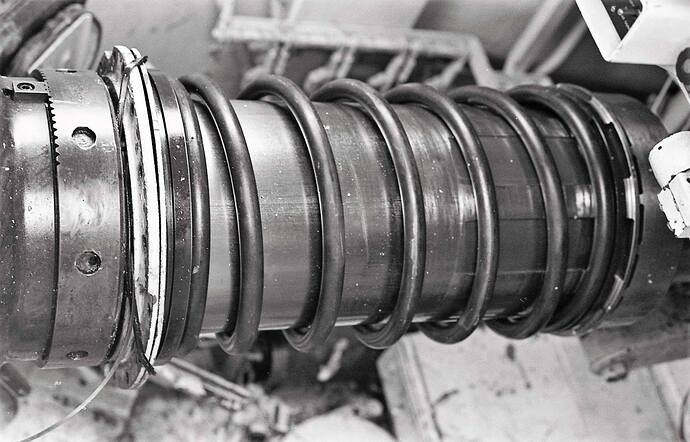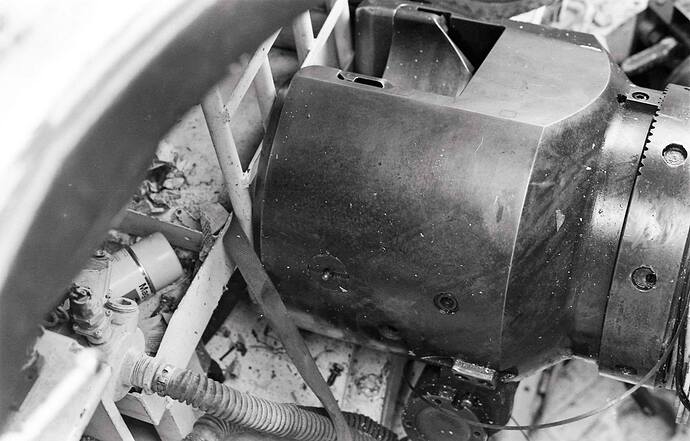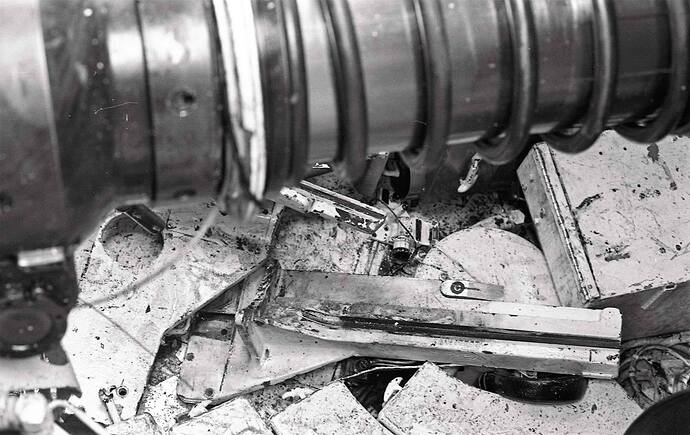I filmed this myself in '74, at the Grafenwoehr Training Center in Germany. We conducted training, and Crew/Vehicle Gunnery Qualifications every year. The Tanks were M-60, or M-60 A1, nothing fancy for us in those Cold War days. There is a bunch of different stuff in it, just daily vignettes. I filmed in Super 8mm (no sound) it was then copied to VHS, thence to DVD, so try not to mind the resolution. Feel free to copy as you like.
https://youtu.be/1ivbTnAevXQ
Must have been comforting to have Jimmy Connors or some other tennis ace and his girlfriend holding back the Commie hordes. 

I recently read Tank Men by Robert Kershaw. If I’d read it before volunteering for an armoured unit, which fortunately didn’t have any tanks as both of Australia’s tanks were in Vietnam at the time with the third one held back for parts ;), I’d have begged to be in the infantry. Or anything but armour. Book is well worth reading for the horror of tank warfare in WWII, by all sides.
Well NATO was well aware that the Warsaw Pact had envious eyes towards West German Tennis Clubs during the Cold War.  I knew the proprietors of the place, and had some film left that day. The Club Pro was a good man, and his Serve may have been a closely guarded Sonderwaffen of the BRD .
I knew the proprietors of the place, and had some film left that day. The Club Pro was a good man, and his Serve may have been a closely guarded Sonderwaffen of the BRD . I met Elke Sommers there just as I was leaving Germany, hard to miss the powder blue XKE with New York plates on it. She was a very nice, and gracious lady.
I met Elke Sommers there just as I was leaving Germany, hard to miss the powder blue XKE with New York plates on it. She was a very nice, and gracious lady.
Armor service was not the most tempting of specialties by any means,especially in the bad days of the Cold War and Artillery would at least keep one well away from the vulgar Brawl of general combat. But the infantry had it worse, and we took care of them, same as they took care of us. The Tanks of my time were fairly reliable, didnt screw up too often but still often enough, and mostly in Winter. The new thinking of the Cold War was that since all nations had pretty much settled on Shaped Charge, and Sabot, or APCR munitions, Armor was not going to be a lot of help as it had been in WW II when steel shot was the usual thing. So, they decided that less armor allowed for more mobility, which could (maybe) keep one from getting hit. The alloy was also changed to allow the incoming munition to pass through with a minimum of secondary problems like splinters spalling, etc. We did know what our chances were in a massed fight. In my film you can see several Target Tanks, and the effects of HEAT rounds on them. like poking a pencil through cheese. I’m going to read the book you mentioned, sounds interesting , Thanks. We had 17 Tanks in my Company, and usually due to the privations of supplying Viet Nam, only 4 or so could start themselves on a cold day, and they had to trundle around the line, and jump start the others. Our Tanks had some issues, like the recoil springs of the main Gun, they would after so many years be prone to breaking, and would result in something like this.
I think you’ll find it worthwhile.
Author is a former military man, although not armour. Book focuses mainly on WWII but starts with WWi and development of tanks and tank warfare from then on. Lots of comparisons of pros and cons of Allied (mainly British, US, Soviet with some French) tanks against Axis in Europe and North Africa. Not unduly technical, but compares the relative advantages and disadvantages of opposing armour and munitions and anti-tank weapons at various times, and the effect of weapons and munitions on tanks and crew. Also looks at tank design and production by various nations, with Britain running it like a cottage industry and Germany doing the same to some extent. Covers evolution of tactics in tank v.tank and infantry support roles. Lots of first hand accounts from Allied and Axis tank crews who survived combat. Surprising number of crews had their tank destroyed and returned to battle in another tank with original or mixed new crew soon after, sometimes many times in a single day.
I’m hoping that there wasn’t a crew member position behind the gun when the spring broke.
Raises an interesting issue about direct combat by service people, unlike infantry, not really trained for or used to it. Dismounted armour; artillery; non-combat troops; air crew; sailors. Similarly their experience of captivity.
Then again, some air crew not used to ground combat adapted to it remarkably quickly and much more effectively than a lot of trained infantry, as did this Australian pilot recommended for a Congressional Medal of Honor for, among other things, clubbing two enemy to death with his empty pistol while saving an American officer.
[i]
Department of the Army
Headquarters 9th Infantry Division
APO San Francisco 96370
20 August 1968
AVDE-CG
Thru Commanding General
7th USAF
Bien Hoa
APO 96307
To Lieutenant Colonel James T. Patrick, USAF
Commanding Officer
19th Tactical Support Squadron
Bien Hoa
APO 96227
Dear Colonel Patrick
I recommend the immediate award of the CONGRESSIONAL MEDAL OF HONOR to Flight Lieutenant Gary G. Cooper, 0219964, Royal Australian Air Force, one of the men in your command serving with the Ninth Division.
Throughout his service as a FAC he has made himself a legend and is highly respected by all my officers. The narrative description of his gallant actions on 18 August 1968 is attached. Although untrained in ground combat he displayed great coolness and heroism under completely overwhelming odds and saved one of my most valuable Brigade Commanders. His actions would have been highly commendable even if carried out by a veteran in ground combat.
Air Force regulations do not permit me to make an award so I strongly recommend the highest recognition.
With warm regards,
Sincerely,
Julian J. Ewell Major General, USA
Commanding
______________________________________________________________________________ 006155
NARRATIVE
Flight Lieutenant Gary G. Cooper, 0219964, distinguished himself by gallantry in action against hostile forces as a forward air controller near Cai Be, Republic of Vietnam on 18 August 1968. Late in the afternoon Flight Lieutenant Cooper was flying as Air Liaison Officer of the Command Helicopter with its pilot and Brigade Commander. They were flying at 200 feet between the friendly and hostile forces. The helicopter was taking numerous hits from the intense automatic weapons fire but it was imperative that they continue directing operations from this position as the friendly forces were pinned down and taking heavy casualties. After thirty minutes under heavy, fire the pilot was shot dead at 200 feet and the helicopter dived toward the ground at tremendous speed. The Brigade Commander had been hit in the back of the neck with the same bullet that disintegrated the pilot’s head and ricocheted off Cooper’s helmet stunning him. Although dazed and covered in blood and brain tissue, Cooper managed to reach across for the controls, overpower the dead pilot and reduce what would have been a fatal impact with the ground. The crash was in open rice paddy country only 200 meters in front of the enemy lines and the helicopter became the primary target for their fire. Friendly troops could hear the automatic weapons fire slamming into the wreckage while Cooper, although finding it difficult to move due to a back injury, assisted the Colonel to a near-by dyke. Here they set up a defensive position as they could move no further and the friendly forces were not in a position to help. They were waist deep in water and throughout the night the enemy made several attempts to creep along the dykes to their position. Each time Cooper managed to ward off the attack and killed at least ten of the enemy at close range. By morning the situation had eased due to constant air strikes on the enemy positions and a pickup helicopter was called for. Weapons fire was again heavy during the pickup and the helicopter had to move away making it necessary for the Colonel and Cooper to run in the open to board it. Now out of ammunition, as Cooper had been covering the Colonel while he was hoisted aboard, he was attacked by two of the enemy who he killed with his empty hand -gun before leaping into the helicopter. Flight Lieutenant Cooper’s outstanding gallantry, professionalism and complete devotion to duty have reflected great credit upon himself and the Free World Military Forces.
______________________________________________________________________________Department of the Air Force
[/i]
More at http://home.earthlink.net/~aircommando1/GCCongMOH1.htm
Although there is room enough for Crew to move across behind the gun, no one is ever behind it when firing, excepting for the time needed for the loader to do his job. The Safety is on during this few seconds, and is at the control of the Loader. I did measure to space and when in full rear position, there is enough space to allow a Crewman to survive being struck by the Breech, but they would be injured to the point of needing a Hospital . Fortunately, Recoil system failures of that sort are extremely rare. Mostly a Spring breaking just holds the Gun out of Battery several inches after recoil is finished, which is what happened to a Tank I was on. It’s an all night job to pull the gun out of the Turret, take it to pieces, and replace everything, then reassemble ( I earned my $327 / Month that night) I had a good Crew of very able guys, although the Lieutenant whose Tank it was, never showed up to do anything, I think that in all Army’s the Officer types just tell the NCO to handle things, then go off to the Officer’s Club for a glass of Port or something. 
 ( All of the work we did on those monsters, and now they sit in Parks, or outside a Veterans Hall.
( All of the work we did on those monsters, and now they sit in Parks, or outside a Veterans Hall.
TG thanks for the cool footage. There’s also a lot of other great vintage Cold War videos there, I watched part of the one on the T-72 and T-64 (how to take them out).
You’re welcome Nick, glad you liked it. The rounds fired in the film were for the most part just HEP, like HESH, they look good when they go up. there were some HEAT as well they made nice orange splashes. The best place to hit the 64, or the 72 was at the Turret ring area. It’s where they kept the main gun ammo. The frontal turret areas were spaced armor, harder to make an immediate impression on them if you hit them there, but not much stops APDS, it was the gold ammo of the cold war. (so expensive though that we got to fire just a single round of it the entire time I was there. ) I’ll have to watch that video, see what they say about the 64, and 72. One thing I can say about the T-72 is that once I got to look one over up close, they were a bit underwhelming, much less than the hype they fed us in the old days. Still it was a dangerous Tank, even though it wasn’t made with Stalinium Armor. 
I believe the T-72 was a cheaper, easier to produce alternative to the T-64, which was considered a very capable tank but was expensive. The Ukrainians worked out the kinks in the 64 and I think their versions are superior even to upgraded T-72’s. Not sure about how good the T-90’s are. I read something recently about a guy that closely studies Syrian (and Russian) use of armor in the war there and he basically said the T-90’s worked quite well and their active defense systems did mitigate losses. However, there were numbers of them destroyed by even the older TOW systems supplied to the FSA and other rebels by the U.S. even though these versions did not attack the top of the armor as the latest generation does.
U.S. forces and their Kurd allies did face some T-72’s recently in that notorious incident where up to 300 pro-regime fighters and Russian mercenaries died, but they were swept aside by airstrikes and possibly Javelins…
Seems I recall that too, The 64 was a toughie, they wouldn’t export that model, it was strictly for their own use. At one point they tried to fill the space between the armor with hard ceramic spheres, suspended in some other material to make it more difficult for Heat Rounds to penetrate. They couldn’t manage to perfect the process enough to make it’s application consistent, so dropped it after awhile. (so they say)
The 72 was interesting, it had a good Gun, and some fire control. the Auto Loader was the fly in the ointment though, it required the munitions to be stored at the turret Ring, which made them very vulnerable to any decent hit in that part of the Tank. Which is why you see so many missing their Turrets. They as were most all the Soviet Tanks, cramped, and presented hazards to the crews who used them. Uncomfortable was the norm, which exhausted the Crews, and the loader could snag the gunner’s arm if he wasn’t careful, and load it as well as the munitions. These Days I’m sure the T-72’s have had upgrades, and refits to make them more survivable, and effective, (but I’m still not very impressed) 
There’s also a lot of other vintage Cold War videos, Best part was T-72.



